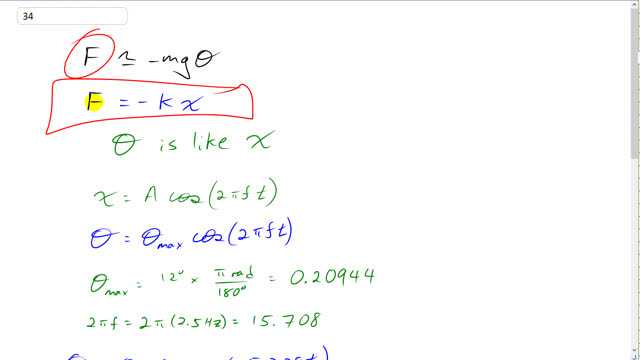
A clock pendulum oscillates at a frequency of 2.5 Hz. At t = 0, it is released from rest starting at an angle of to the vertical. Ignoring friction, what will be the position (angle in radians) of the pendulum at
- t = 0.25 s,
- t = 1.60 s, and
- t = 500 s?

In order to watch this solution you need to have a subscription.
This is Giancoli Answers with Mr. Dychko. Knowing that the restoring force on a pendulum is approximately equal to negative mg θ, we can compare that to this formula for Hooke's law which is formula for the restoring force in a simple harmonic oscillator which is f is negative kx and we can see that x and θ are similar. So, any equation that we have for x we can instead write θ there. So, we have this equation for position as a function of time amplitude times cos 2π times frequency times time. And we can instead write it as θ equals the maximum θ times cos 2π frequency times time. And θ maximum is 12 degrees times π radians for every 100 degrees or 180 degrees to convert it into radians, 0.20944. And 2π f we come out as 2π times 2.5 hertz which is 15.708. And here is our equation for θ as a function of time. And then for a, b and c we just plug in the different times, 0.25 seconds, 1.6 seconds or 500 seconds. And plug and chug to get our answer. Negative 0.15 radians in the first case and 0.21 radians for both b and c.
Hi Professor Dychko,
You said that theta and X are similar and therefore interchangeable which I understand; but why can we sub out amplitude and replace it with theta max? How are the two related?
Thanks!
Hi aheumangutman, thanks for the question. Seeing as and are interchangable, let's rewrite the position formula for a simple harmonic oscillator in a way that might answer your question. Normally this position is written as , which means the position at a particular time is some fraction (since cos is always less than 1) of the maximum position. So let's rewrite that as . If then it stands to reason that because we're considering to represent a 'position' now, and if the formula is asking for the maximum position (normally called the amplitude), then that's where we write .
Hope that helps,
Mr. Dychko
I am using Mathway the Trig calculaor and I get for for part a) −0.14809508 so I can see after rounding it is -0.15
for part b) i get 0.18961143 and part c) 0.08518692. Could you please help with this?
Hello, thank you for your question. Typing 0.20944*cos(15.708) into https://www.mathway.com/Trigonometry gives the same result as here: 0.21. I'm not sure why you're seeing something different.
All the best,
Shaun